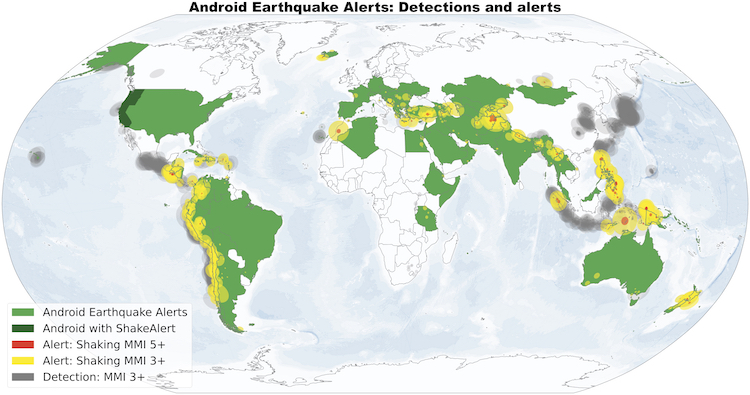Science
Android Smartphones Emerge as Life-Saving Earthquake Alerts

The global network of Android smartphones has been identified as an effective early warning system for earthquakes, potentially providing users with critical seconds to respond before seismic activity begins. This conclusion stems from a comprehensive study conducted by researchers at Google, which involved millions of devices across 98 countries over the span of three years.
Leveraging Smartphone Technology for Earthquake Detection
The research highlights the capacity of the Android Earthquake Alert (AEA) system, which utilizes the built-in accelerometers in smartphones. According to Richard Allen, a co-leader of the study and a visiting faculty researcher at Google, the system can extend life-saving alerts to regions that lack traditional earthquake early warning systems. “By using Android smartphones, which constitute approximately 70% of smartphones worldwide, the AEA system can help provide warnings in many places globally,” Allen stated.
Traditional earthquake early warning systems rely on dedicated seismic sensors, first implemented in countries like Mexico and Japan, and now also in regions such as Taiwan, South Korea, and parts of Canada. These systems are adept at detecting seismic activity near the epicenter and issuing alerts quickly. Even a few seconds of warning can significantly impact safety, allowing individuals to engage in protective actions such as the widely recommended “drop, cover, and hold on” (DCHO) method.
Building conventional seismic networks can be prohibitively expensive, leaving many earthquake-prone areas without effective warning systems. In contrast, the widespread ownership of smartphones offers a unique solution. While the accelerometers in smartphones are less sensitive than those in dedicated seismic instruments, they are still capable of detecting strong tremors during significant earthquakes. Allen noted, “Although the accelerometers in these phones are less sensitive than the permanent instruments used in traditional seismic networks, they can still detect tremors during strong earthquakes.”
Testing and Impact of the AEA System
The AEA system underwent rigorous testing from 2021 to 2024, where it detected an average of 312 earthquakes monthly, with magnitudes ranging from 1.9 to 7.8. Significant seismic events included those in Japan and Türkiye. For earthquakes measuring 4.5 or more on the Richter scale, the AEA issued “TakeAction” alerts designed to prompt users to take immediate protective measures. During the study, the system sent out an average of 60 alerts per month, reaching approximately 18 million individual alerts.
In addition to immediate alerts, the system also issued “BeAware” notices for regions anticipating shaking intensity levels of 3 or 4. To evaluate user response and the effectiveness of these alerts, the researchers collected feedback through Google Search user surveys. From 5 February 2023 to 30 April 2024, over 1,555,006 individuals responded. The findings revealed that 85% felt shaking, with 36% receiving alerts prior to the tremors, 28% during, and 23% after the shaking began.
The AEA functions on principles similar to those of traditional seismic systems, detecting seismic wave propagation. When an Android smartphone is stationary, its accelerometer identifies sudden increases in acceleration indicative of P and S waves characteristic of earthquakes. Once a tremor is detected, the device communicates with Google servers, which analyze the data to confirm the event and estimate magnitude and origin time.
As this detection capability is integrated into Google Play Services, it is enabled by default on the majority of Android devices. With billions of Android smartphones in circulation, the AEA system stands to provide earthquake detection capability across diverse geographical and economic landscapes.
Looking ahead, Allen and his colleagues aim to refine the AEA system further. They envision using the system’s data to create additional tools for hazard reduction, including ground shaking maps that could aid emergency responses post-earthquake. “We are learning from earthquakes as they occur around the globe, and the Android Earthquake Alerts system is helping to collect information about these natural disasters at a rapid rate,” Allen remarked. “We think that we can continue to improve both the quality of earthquake detections and our strategies to deliver effective alerts.”
The findings from this study have been published in the journal Science, marking a significant advancement in the use of technology for public safety in earthquake-prone regions.
-

 Health3 months ago
Health3 months agoNeurologist Warns Excessive Use of Supplements Can Harm Brain
-

 Health3 months ago
Health3 months agoFiona Phillips’ Husband Shares Heartfelt Update on Her Alzheimer’s Journey
-

 Science1 month ago
Science1 month agoBrian Cox Addresses Claims of Alien Probe in 3I/ATLAS Discovery
-

 Science1 month ago
Science1 month agoNASA Investigates Unusual Comet 3I/ATLAS; New Findings Emerge
-

 Science4 weeks ago
Science4 weeks agoScientists Examine 3I/ATLAS: Alien Artifact or Cosmic Oddity?
-

 Entertainment4 months ago
Entertainment4 months agoKerry Katona Discusses Future Baby Plans and Brian McFadden’s Wedding
-

 Science4 weeks ago
Science4 weeks agoNASA Investigates Speedy Object 3I/ATLAS, Sparking Speculation
-

 Entertainment4 months ago
Entertainment4 months agoEmmerdale Faces Tension as Dylan and April’s Lives Hang in the Balance
-

 World3 months ago
World3 months agoCole Palmer’s Cryptic Message to Kobbie Mainoo Following Loan Talks
-

 Science4 weeks ago
Science4 weeks agoNASA Scientists Explore Origins of 3I/ATLAS, a Fast-Moving Visitor
-

 Entertainment4 months ago
Entertainment4 months agoLove Island Star Toni Laite’s Mother Expresses Disappointment Over Coupling Decision
-

 Entertainment3 months ago
Entertainment3 months agoMajor Cast Changes at Coronation Street: Exits and Returns in 2025









